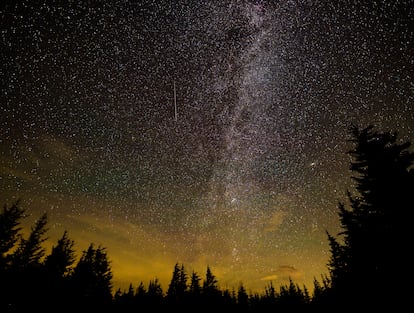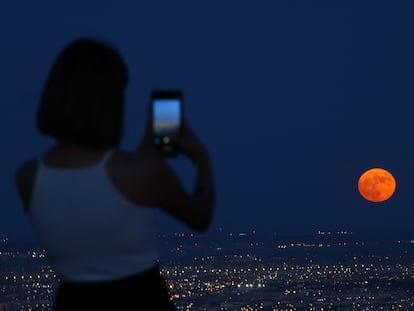Every Meteor Shower left in 2023 and how to see them in the US
Several meteor showers will be seen in the night sky these last months of the year and they can be seen from American territory

Meteor showers are celestial events during which several meteors are observed to radiate or originate from one point in the night sky. They are caused by streams of cosmic debris called meteoroids that enter the Earth’s atmosphere at high speed on parallel trajectories.
These phenomena are favorites among stargazers and can be seen by anyone under the right conditions. Most of them are visible from the northern hemisphere, allowing U.S. residents to find a place to enjoy them. Here are the meteor showers to be seen during this last months of the year.
Andromedids, September 25 to December 6
The Andromedids meteor shower occurs as Earth passes through old streams left by Biela’s Comet, which broke up in either 1842 or early 1843 when the comet was near Jupiter. This breakup led to meteor showers that could be seen with the naked eye.
Since the 19th Century, the Andromedids faded and were no longer visible to the naked eye. In recent years, peak activity has been less than three meteors per hour. However, scientists expect a stronger return this year with up to 200 meteors an hour. It reached its peak on November 6, but according to the International Meteor Organization, the best date to watch them will be December 2 at 19:00 UT.
Leonids, November 3 to December 2
The Leonids meteor shower occurs every 33 years and is associated with the comet Tempel-Tuttle. They get their name from the location of their radiant in the constellation Leo. It is the fastest annual meteor shower and also produces meteor storms about every 33 years, during which activity exceeds 1,000 meteors per hour, with some events exceeding 100,000 meteors per hour.
This year, its peak will be on November 18, with a Zenithal Hourly Rate of 15 meteors.
Alpha Monocerotids, November 15-25
The Alpha Monocerotids are the more prominent of two showers that originate from the constellation of Monoceros. It is active from November 15 to 25, with its peak occurring on November 21 or 22. It normally has a low Zenithal Hourly Rate but occasionally produces more intense storms that last less than an hour. However, this year it is expected to have a low ZHR.
Northern Taurids: October 20 to December 10
The Northern Taurids originated from the asteroid 2004 TG10, which is possibly a large fragment of Comet Encke. They are named after their radiant point in the constellation Taurus and occur during October 13 to December 2. Their peak will be on November 21-22.
Southern Taurids: September 10 - November 20
The Southern Taurids originated from Comet Encke. This meteor shower occurs during September 23 and December 8, with its peak date being November 5.
The Northern and Southern Taurids are also called Halloween fireballs because of the date when they occur and the size of the meteors, as they may become bolides as bright as the moon, leaving smoke trails behind them. Some years, fireballs have been seen during these meteor showers.
Phoenicids, November 29 to December 9
The Phoenicids are a minor meteor shower that gets its name from the constellation Phoenix. Its peak can occur around December 5 or 6 each year and is best seen from the Southern Hemisphere. They appear to be associated with a disintegrating comet called 289P/Blanpain.
Conditions are poor for enjoying the Phoenicids in 2023.
How to watch a meteor shower?
To enjoy a meteor shower, the first thing is to know its schedule and its peak date, which is the day when there are better conditions to see it.
Check the Moon Phase
Try to observe meteor showers when the moon is in its crescent phase or when it’s not in the sky during the peak hours. A bright moon can wash out the fainter meteors, making them harder to see.
Find a dark location
Go to a location away from city lights, preferably in a rural or suburban area, where the night sky is darker, and stars are more visible. Dark sky areas are perfect for meteor shower watching.
Check the weather
Ensure that the weather forecast is clear and favorable for stargazing. Cloud cover can obstruct your view of the meteor shower.
Arrive early
Set up early, allowing your eyes to adjust to the darkness. This process, known as dark adaptation, helps in seeing fainter meteors.
Use apps
Utilize astronomy apps or star maps like SkySafari, Star Walk, or Google Sky Map to identify constellations or the radiant point of the meteor shower.
Limit light pollution
Avoid using bright lights, such as phone screens or flashlights, as they hinder your night vision. Red light is less disruptive to night vision, so consider using a red flashlight if needed.
Focus on the radiant point
Meteor showers appear to originate from a specific point in the sky, known as the radiant point. However, meteors can streak across any part of the sky, so it’s essential to keep an open view.
Remember: meteor showers are unpredictable
Meteor showers can be unpredictable. Some showers might have several meteors visible in a short time, while others may have longer intervals between sightings. Stay patient and allow enough time to observe the sky.
Sign up for our weekly newsletter to get more English-language news coverage from EL PAÍS USA Edition
Tu suscripción se está usando en otro dispositivo
¿Quieres añadir otro usuario a tu suscripción?
Si continúas leyendo en este dispositivo, no se podrá leer en el otro.
FlechaTu suscripción se está usando en otro dispositivo y solo puedes acceder a EL PAÍS desde un dispositivo a la vez.
Si quieres compartir tu cuenta, cambia tu suscripción a la modalidad Premium, así podrás añadir otro usuario. Cada uno accederá con su propia cuenta de email, lo que os permitirá personalizar vuestra experiencia en EL PAÍS.
¿Tienes una suscripción de empresa? Accede aquí para contratar más cuentas.
En el caso de no saber quién está usando tu cuenta, te recomendamos cambiar tu contraseña aquí.
Si decides continuar compartiendo tu cuenta, este mensaje se mostrará en tu dispositivo y en el de la otra persona que está usando tu cuenta de forma indefinida, afectando a tu experiencia de lectura. Puedes consultar aquí los términos y condiciones de la suscripción digital.
More information
Últimas noticias
Mustafa Suleyman: ‘Controlling AI is the challenge of our time’
Venezuela breaks energy agreements with Trinidad and Tobago due to alleged complicity with the US
The murder of Michele and Rob Reiner: A tale of horrific days in Hollywood
Trump orders a ‘complete blockade of sanctioned oil tankers’ going to and from Venezuela
Most viewed
- ‘El Limones’ and the growing union disguise of Mexican organized crime
- Christian Louboutin: ‘Young people don’t want to be like their parents. And if their parents wear sneakers, they’re going to look for something else’
- ‘We are dying’: Cuba sinks into a health crisis amid medicine shortages and misdiagnosis
- A mountaineer, accused of manslaughter for the death of his partner during a climb: He silenced his phone and refused a helicopter rescue
- The low-cost creative revolution: How technology is making art accessible to everyone











































